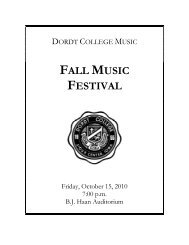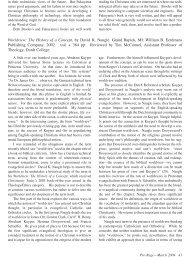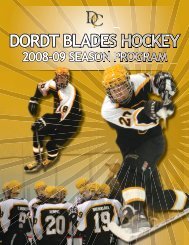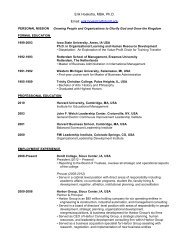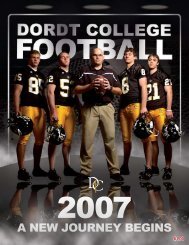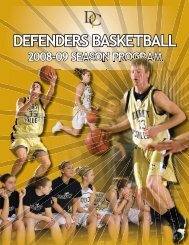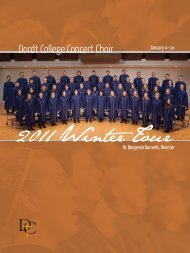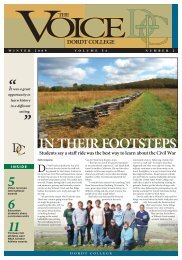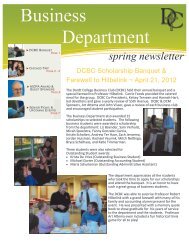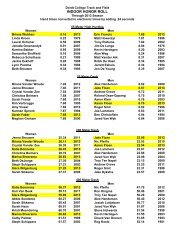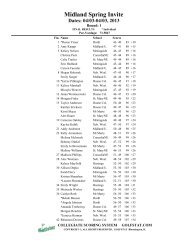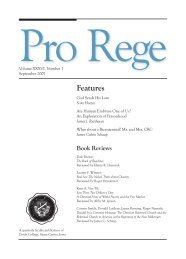June 2009 - Dordt College
June 2009 - Dordt College
June 2009 - Dordt College
You also want an ePaper? Increase the reach of your titles
YUMPU automatically turns print PDFs into web optimized ePapers that Google loves.
graced beauty of the dancers, hint at a world entered that is<br />
otherwise than our present flawed reality. To readers, that<br />
may be stating the obvious.<br />
Brown discusses how dance is portrayed in the Bible,<br />
i.e., positively. This section I found to be quite illuminating,<br />
bringing meaning to the text not previously appreciated.<br />
He goes on to discuss dance in ancient Greek culture, in<br />
Hinduism, Buddhism, Judaism, and Islam. He then returns<br />
to the rather sparse use of dance in the history of Christianity,<br />
concluding that dance as a metaphor should be replaced by<br />
its literal counterpart (89). Some of his deductions about<br />
dance providing the possibility of experiencing the divine<br />
seem rather forced and unconvincing, but he also discusses<br />
works that are more obviously religiously oriented.<br />
My disagreements with Brown arise out of our<br />
different Christian convictions. For example, from his<br />
almost Catholic point of view, the dance Messa Concertata<br />
was “not of course an act of worship, in the sense that no<br />
altar was used and there was no priest to celebrate the<br />
mass ….” (109). From my standpoint, and with the<br />
support of Romans 12:1, what one does with one’s body,<br />
including dance, can be a “spiritual act of worship.” Some<br />
of his other interpretations and generalizations may prove<br />
to be controversial, too. Moreover, by frequently stating<br />
the obvious, the book can become somewhat tedious.<br />
In the passage dealing with “gratitude to God in<br />
adversity” (128-29), Brown takes Mother Teresa as an<br />
example. He must have written that before her “dark night<br />
of the soul” became public knowledge with the publication<br />
of the book Mother Teresa: Come Be My Light (September<br />
2007). Her “winning smile,” it turns out, did not reveal<br />
“a tremendous serenity,” as Brown claims, but rather<br />
obscured her own frequent feelings of alienation from God<br />
and her longing for “the answering smile of God himself.”<br />
Yet Brown’s book also has much that is fascinating. His<br />
observations on hospitality in particular are insightful and<br />
heart-warming (130-35). Besides, the whole chapter on<br />
food and drink merits special consideration.<br />
The second part of the book is devoted to music. Brown<br />
claims that music in all its variety opens up the possibility<br />
of experiencing God (even if only partially). Brown seems<br />
to work from a dualist worldview, that of the sacred and<br />
the secular, especially when arguing that the themes of<br />
certain music “widen the range of religious experience<br />
beyond the church door” (349). How many people ever<br />
limited religious experience to the church However, in the<br />
very last chapter he claims to have rebelled against “views<br />
of religious experience that strongly oppose the sacred and<br />
the secular, revealed and natural religion” (422). So if he<br />
is not a dualist, he has been setting up straw men in order<br />
to tear them down. Perhaps the trouble lies in his use of<br />
the word “sacrament.” If he had limited that to refer to<br />
baptism and the Eucharist, and had used “the sacred” to<br />
denote what potentially “might include all of life” (422),<br />
then all that we experience in our bodies, minds, and spirits<br />
can be sacred, set apart for holy use. All of life can be lived<br />
unto the Lord.<br />
The chapters on music, especially the one on “Pop<br />
Music,” rather ignore the body for the most part and have<br />
more to say about the supposed ability of music to induce<br />
religious experience. Brown’s talk about music’s “power to<br />
provide significant openings for the outworkings of God’s<br />
purposes” (346) seems to be close to suggesting that without<br />
music God would be unable to work. The argument seems<br />
rather labored. Just because God or soul are mentioned does<br />
not necessarily make a song spiritual. And even a distinctly<br />
spiritual song cannot guarantee a spiritual response from<br />
the listener, or even the singer, as proven by some of the<br />
examples mentioned by Brown. Instrumental music can be<br />
received in various ways also.<br />
Part III on the “Eucharistic Body” is the smallest<br />
section of the book. It discusses the history of how the<br />
church understood the meaning of the Eucharist and<br />
Christ’s body. Here again, Brown makes generalizations<br />
that do not resonate with all Christians.<br />
The abundant references to art, literature, music,<br />
and other sources are wide-ranging in scope and time.<br />
Fortunately, it is possible to view and even hear many of the<br />
artistic works referred to in the book on the internet. Of<br />
course, that turns reading it into a whole course of culturalmusical<br />
education! But the fact that the book incites the<br />
reader to want to check out the sources is an indication of<br />
the fascination it arouses.<br />
I noticed some errors of writing and editing, such<br />
as where Brown mistakenly refers to the “maiden who<br />
represents poverty” before going on to say that “Only<br />
poverty is depicted as male” (115). Plate 7 confirms that<br />
it should be a youth representing poverty. Brown refers to<br />
Ecclesiastes (398), whereas he means Ecclesiasticus, the<br />
deuterocanonical book. In the footnotes, the plates are<br />
referred to as being at the end of the book, whereas they<br />
are placed in the middle. The plates, with supplementary<br />
commentary, are in black and white, but Brown helpfully<br />
refers the reader to publications that provide them in<br />
color.<br />
Despite my criticisms of the book, Brown has quite<br />
whetted my appetite for reading the other volumes in this<br />
threesome, especially as he promises to discuss the “whole<br />
issue of the use of body in worship” (91) in the third.<br />
24 Pro Rege—<strong>June</strong> <strong>2009</strong>



